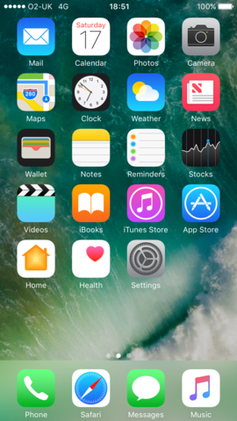IOS
 |
|

iOS 10 running on an iPhone 7
|
|
| Developer | Apple Inc. |
|---|---|
| Written in | C, C++, Objective-C, Swift |
| OS family | Unix-like, based on Darwin (BSD), macOS |
| Working state | Current |
| Source model | Closed source |
| Initial release | June 29, 2007 |
| Latest release | 10.2.1 (14D27)(January 23, 2017) |
| Latest preview | 10.3 (14E5230e) (January 24, 2017) |
| Marketing target | Smartphones, tablet computers, portable media players |
| Available in | 40 languages |
| Update method | iTunes or OTA (iOS 5 or later) |
| Platforms |
|
| Kernel type | Hybrid (XNU) |
| Default user interface | Cocoa Touch (multi-touch, GUI) |
| License | Proprietary software except for open-source components |
| Official website | www |
iOS (formerly iPhone OS) is a mobile operating system created and developed by Apple Inc. exclusively for its hardware. It is the operating system that presently powers many of the company's mobile devices, including the iPhone, iPad, and iPod touch. It is the second most popular mobile operating system globally after Android. iPad tablets are also the second most popular, by sales, against Android since 2013.
Originally unveiled in 2007 for the iPhone, iOS has been extended to support other Apple devices such as the iPod Touch (September 2007) and the iPad (January 2010). As of January 2017[update], Apple's App Store contains more than 2.2 million iOS applications, 725,000 of which are native for iPads. These mobile apps have collectively been downloaded more than 130 billion times.
The iOS user interface is based upon direct manipulation, using multi-touch gestures. Interface control elements consist of sliders, switches, and buttons. Interaction with the OS includes gestures such as swipe, tap, pinch, and reverse pinch, all of which have specific definitions within the context of the iOS operating system and its multi-touch interface. Internal accelerometers are used by some applications to respond to shaking the device (one common result is the undo command) or rotating it in three dimensions (one common result is switching between portrait and landscape mode).
Major versions of iOS are released annually. The current version, iOS 10, was released on September 13, 2016. It runs on the iPhone 5 and later, iPad (4th generation) and later, iPad Pro, iPad Mini 2 and later, and the 6th-generation iPod Touch. In iOS, there are four abstraction layers: the Core OS, Core Services, Media, and Cocoa Touch layers.
...
Wikipedia
